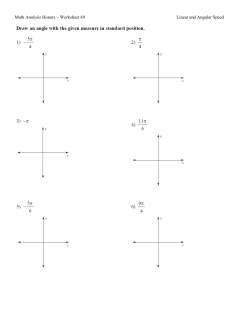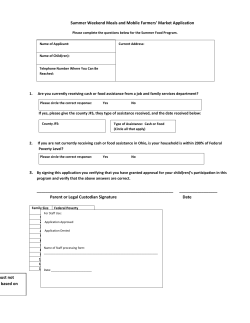
Revolution
Geometry – Unit 7-1 Practice
The Angle Revolution
Name: _____________________________!
Date: ___________ Pd: ____
G.C.B.5
Revolution – full circle, turn, full turn or rotation.
1 revolution = 1 full circle = 1 turn = 1 rotation = 1 circle = 360°
Degree – used in mathematics to measure angles,
1 full circle = 360°
1
of the circumference of a circle.
360
It’s an obvious fact that circles should have 360 degrees. Right?
Wrong. Most of us have no idea why there’s 360 degrees in a circle. We memorize a magic number as the “size of a circle”
and set ourselves up for confusion when studying advanced math or physics, with their so called “radians”.
Here’s a theory about how degrees came to pass:
• Humans noticed that constellations moved in a full circle every year
• Every day, they were off by a tiny bit (“a degree”)
• Since a year has about 360 days, a circle had 360 degrees
But, but… why not 365 degrees in a circle?
Cut ‘em some slack: they had sundials and didn’t know a year should have a convenient 365.242199 degrees like you do.
360 is close enough for government work. It fits nicely into the Babylonian base-60 number system, and divides well (by 2,
3, 4, 6, 10, 12, 15, 30, 45, 90… so you get the idea).
Radians – used in advanced mathematics to measure angles.
Invented in the 1700’s by mathematicians who wanted to define angles rationally, radians were
determined from the circumference of a circle with a radius of 1. One radian is just under 57.3°.
1 full circle = 2π radians
“Radians make math easier!” the experts say, without a simple reason why.
Imagine watching a friend run the track from a position inside the track, degrees measure the amount you need to turn
your head to see him run. Radians measure angles by distance traveled.
But absolute distance isn’t that useful, since going 10 miles is a different number of laps depending on the track. So we
divide by radius to get a normalized angle:
You’ll often see this as
or angle in radians (theta) is arc length (s) divided by radius (r).
In plain English, 1 radian is what you get when the length of the segment of the circle’s circumference being measured is
equal to the length of the radius.
Radians are a count of distance in terms of “radius units”; think of “radian” as shorthand for that concept.
SNRPDP
Unit 7-1: Circular Measurement, Area & Volume
NVACS – Revised 2014-2015
Page 1 of 4
Practice – Unit 7-1 (cont.)
Fill in the radian measures to compare revolutions, degrees and radians:
DIAGRAM
WORDS
REVOLUTIONS
DEGREES
…?...
RADIANS
no turn
0
0°
0
quarter turn
1/4
90°
______
half turn
1/2
180°
______
three-quarter
turn
3/4
270°
______
full turn
1
360°
______
twelfth turn
1/12
30°
______
eighth turn
1/8
45°
______
sixth turn
1/6
60°
______
Page 2 of 4
Practice – Unit 7-1 (cont.)
fifth turn
1/5
72°
______
third turn
1/3
120°
______
two turns
2
720°
______
three turns
3
1080°
______
Conversions:
In one full circle, there are 360 degrees or 2π radians. Therefore we know that 2π radians = 360 degrees. Since
the angles within the circle divide the 2π radians proportionately, we can use simple proportions to convert
between degrees and radians.
degree measure radian measure
=
360
2π
Example: Convert 270° to radians.
270
x
=
360 2π
fill in known and unknown values
540π = 360x
find cross-product
540
π =x
360
solve for x
3
π =x
2
3
π
SO… 270° = 2 radians
simplify
Page 3 of 4
Practice – Unit 7-1 (cont.)
2
π
Example: Convert from 3 radians to degrees.
2
π
x
3
fill in known and unknown values
=
360 2π
find cross-product
2π x = 240π
240π
solve for x
x=
2π
x = 120
2
π
SO… 3 radians = 120°
simplify
We can also use the conversion equations:
180
degree measure = radian measure
π
π
radian measure = degree measure
180
OR
Compile your results here, you may need to calculate some conversions:
{degrees, radians}
{______ , _______}
{______ , _______}
{______ , _______}
{______ , _______}
{______ , _______}
{______ , _______}
{______ , _______}
{______ , _______}
{______ , _______}
{______ , _______}
{______ , _______}
0 {______ ,
{______ , _______}
_______}
{______ , _______}
{______ , _______}
{______ , _______}
{______ , _______}
{______ , _______}
{______ , _______}
{______ , _______}
{______ , _______}
{______ , _______}
{______ , _______}
{______ , _______}
Page 4 of 4
© Copyright 2025









